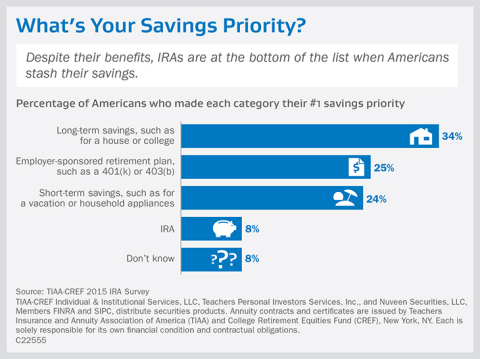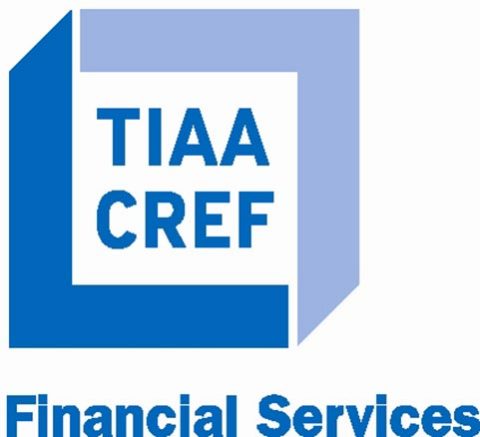NEW YORK--(BUSINESS WIRE)--In the fourth annual TIAA-CREF IRA survey, 24 percent of Americans said short-term savings, such as for a vacation or household appliances, is their first priority when deciding how to allocate savings. That’s three times the number (8 percent) who said contributing to an Individual Retirement Account (IRA) is their first priority, and in parity with the number (25 percent) who said they would prioritize contributing to an employer-sponsored retirement plan, such as a 401(k) or 403(b) plan.
Considering these findings, it may not be surprising that a significantly low number of respondents (only 18 percent) report that they are currently contributing to an IRA. Another 14 percent say they have an IRA, but they are not currently contributing anything to it.
Yet people do recognize the potential benefits of saving in an IRA: Of those Americans who do not currently have an IRA, 56 percent of Americans said they would consider an IRA as part of their retirement strategy, an increase from 47 percent in 2014.
“These results point to an important opportunity to understand what is keeping people from making the most of tax-advantaged savings, and IRAs specifically, to help build a nest egg for retirement,” said Doug Chittenden, executive vice president, Individual Business for TIAA-CREF. “Once people know about IRAs and understand the difference an IRA can make, they tend to take advantage of this option. Among TIAA-CREF participants, for instance, 41 percent are contributing to an IRA, and another 30 percent have an IRA and are not currently making contributions. But the data suggests that without some additional information and assistance, the gap between what Americans say and what they do will persist, with serious results when they stop working.”
The TIAA-CREF 2015 IRA survey was conducted by an independent research firm and polled a random sample of 1,013 adults nationwide to assess their attitudes, preferences and behaviors related to IRAs.
Where is the disconnect in IRA savings?
Those Americans who have recognized the benefits of an IRA are making the most of them: Among those who are contributing to an IRA, 40 percent are contributing the maximum amount.
Of those who are not taking advantage of IRAs, the problem may be a lack of understanding about how an IRA can benefit long-term retirement planning. For instance, of the survey respondents who are not currently contributing to an IRA and would not consider one as part of their retirement strategy, 39 percent said they don’t know enough about IRAs to consider one – up from 29 percent in TIAA-CREF’s 2014 IRA survey.
Various age groups show different levels of knowledge about IRAs, accompanied by different behaviors. For example, only 46 percent of respondents ages 18-34 were able to correctly identify an IRA, compared to 57 percent overall. Not surprisingly, 18- to 34-year-olds are also the least likely to be contributing to an IRA. (See more results in the TIAA-CREF 2015 IRA Survey Executive Summary).
Furthermore, knowledge about IRAs increases markedly as income level rises, and the same is true of education levels. College graduates are far more likely to be contributing to an IRA at 28 percent, versus 18 percent overall. Sixteen percent of those with some college education are contributing to an IRA, while only 12 percent of those with a high school education or less are contributing.
Given the huge deficit in retirement savings in our country – the Pension Rights Center, in conjunction with a U.S. Senate hearing, calculates that deficit to be as much as $7.7 trillion – these low participation levels have significant implications.
“A knowledge gap, especially at lower income and education levels, persists around IRAs and their role in constructing a comprehensive retirement strategy,” said Chittenden. “Contributing the maximum amount to an IRA brings the greatest benefit, but even opening an IRA and adding just a small amount each month is a great start that offers the advantages of compounded investment growth and tax savings over time.”
An IRA can be a sensible option for employer-sponsored plans left behind
As Americans change jobs, more seem to be leaving their assets in their employer-sponsored plans. This year, 30 percent of respondents said they have savings in one or more employer-sponsored plans, up from 22 percent in 2014 and 15 percent in 2013.
Thirty percent say they have done so because they are satisfied with their past employer’s retirement savings option. However, 23 percent said they didn’t know a rollover was an option; 20 percent said they didn’t know what to do, so they left their money in their past employer’s plan; and 15 percent who didn’t roll over their plan due to lack of time. Women were more likely to say they left retirement savings with their former employer because they didn’t know their options (27 percent of women versus 13 percent of men).
However, respondents say they would consider rolling over those funds into an IRA. Seventy-one percent said the ability to see all of their retirement savings in one place—a key benefit of IRAs—would make them more likely to do so. Respondents also said they would consider an IRA if an IRA specialist who could answer questions and simplify the process was available (63 percent); and if it had lower-cost investment options than their current plan (57 percent).
When determining what to do with the savings in a previous employer’s plan, it’s important to consider all of the options, including leaving it where it is, rolling it into a new employer’s plan (if one is available and rollovers are permitted, or withdrawing cash. Each option has advantages and disadvantages, including investment options, services, fees and expenses, withdrawals, required minimum distributions, other plan features and tax treatment.
IRAs are a powerful complement to workplace retirement plans
More Americans than last year are on their own in ensuring their retirement readiness: Of the respondents who are currently contributing to an IRA, 46 percent said they do not have an employer-sponsored plan, such as a 401(k) or a 403(b), up from 38 percent in 2014.
However, of respondents who would not consider contributing to an IRA, 28 percent said they would not consider it because they already have an employer-sponsored plan such as a 401(k) or a 403(b) and don’t need an IRA.
“An alarming number of people don’t have access to a 401(k) or a 403(b) plan through work,” said Chittenden. “But, for those who do, even though an employer-sponsored plan and an IRA can each stand alone as an effective retirement plan option, it’s important to consider an IRA as part of a mix of savings choices. Among other benefits, an IRA is a great investment option after maxing out 401(k) contributions. It’s important to get sound advice on how these options work best together.”
IRAs can help with a strategy beyond “Work forever”
A financial advisor can help individuals think critically about their investment options and their long-term financial needs in retirement, and what they might do if they run out of money in retirement. For example, when asked “What might you do first if you deplete your retirement savings account sooner than planned?” those already of retirement age had very different responses from their younger counterparts.
Sixty-four percent of respondents under 65 said they would “Head back to work” if their savings ran out, compared to only 35 percent of respondents ages 65 and older. By contrast, those ages 65 and older were twice as likely to say they would sell their possessions (23 percent versus 10 percent overall) or live with their children (15 percent versus 9 percent overall).
“There’s an opportunity to educate younger workers about a retirement strategy that can ensure they don’t outlive their money,” said Chittenden. “At a younger age, it can be difficult to appreciate the limitations that could prevent people 65 and older from going back to work if they deplete their savings.”
TIAA-CREF helps individuals plan for their financial well-being and build their confidence by offering a variety of resources and interactive tools related to financial advice and goal-setting. In addition to its online Advice and Guidance Center, TIAA-CREF offers educational programs focusing on trending financial issues and organizes financial empowerment workshops for women. The company offers access to financial consultants via phone and at more than 100 offices across the country.
For more information on the survey, please read the 2015 TIAA-CREF IRA Survey Executive Summary. For more information on TIAA-CREF’s Advice and Guidance offerings, visit our Advice and Guidance Center.
Survey Methodology
The survey was conducted by KRC Research by phone among a national random sample of 1,013 adults, age 18 years and older, from Feb. 19-22, 2015, using a combination of landline and cell phone interviews. The margin of error for the entire sample is plus or minus 3.1 percentage points.
About TIAA-CREF
TIAA-CREF (www.tiaa-cref.org) is a national financial services organization with $851 billion in assets under management (as of 12/31/2014) and is a leading provider of retirement services in the academic, research, medical and cultural fields.
Disclosures
TIAA-CREF Individual & Institutional Services, LLC, Teachers Personal Investors Services, Inc., and Nuveen Securities, LLC, Members FINRA and SIPC, distribute securities products. Annuity contracts and certificates are issued by Teachers Insurance and Annuity Association of America (TIAA) and College Retirement Equities Fund (CREF), New York, NY. Each of the foregoing is solely responsible for its own financial condition and contractual obligations.
Prior to rolling over, consider your other options. You may also be able to leave money in your current plan, withdraw cash or roll over the assets to your new employer's plan if one is available and rollovers are permitted. Compare the differences in investment options, services, fees and expenses, withdrawal options, required minimum distributions, other plan features, and tax treatment. Speak with a TIAA-CREF Consultant and your tax advisor regarding your situation. Learn more.
TIAA-CREF products may be subject to market and other risk factors. See the applicable product literature, or visit www.tiaa-cref.org for details.
© 2015 Teachers Insurance and Annuity Association of America-College Retirement Equities Fund (TIAA-CREF), 730 Third Avenue, New York, NY 10017
C22551




